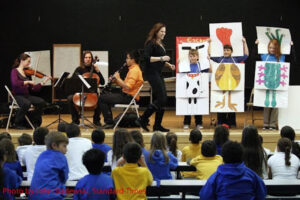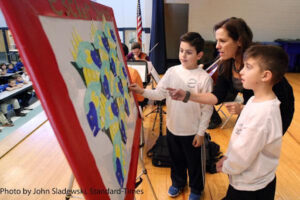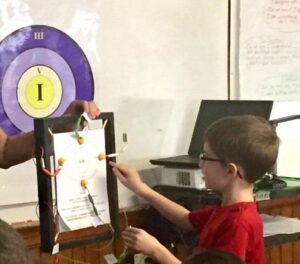
Learning in Concert Program
The Learning in Concert Program, sponsored by the New Bedford Symphony Orchestra (NBSO), New Bedford, MA, in collaboration with local schools, is a unified, multi-phase arts integration curriculum and performance program.
Learning in Concert is a concept-based arts integration model in which musical concepts are explored alongside other art and academic areas that authentically share the same concept. This model promotes learning through active connection-making as it allows the children to develop deeper and more flexible understandings than would have been possible by learning in one subject alone.
Learning in Concert is an adaptive program designed to meet the specific needs of a wide range of organizations by unifying often disparate and unconnected educational outreach activities with a core curriculum. For example, most symphony orchestras have some form of educational outreach activities such as youth concerts, in-school performances by musicians, and other examples. However, these activities are frequently unrelated to each other or have a common educational goal. Without any major restructuring of an orchestra’s educational programming, the Learning in Concert program features the flexibility to create a unified curriculum and performance program that weaves together these existing, but often unrelated elements to create powerful, high impact learning experiences for school children that span an entire school year and yields measurable achievement in music and other academic areas.
The Learning in Concert program is presently being utilized by the New Bedford Symphony Orchestra as a major element of their educational outreach program to partner with over 50 elementary schools in Massachusetts and Rhode Island.
For the 2016-2017 program Gravity in Space and Sound, please watch https://youtu.be/WhvcgciiKi4
 NBSO’s Young People’s Concert culminating event
NBSO’s Young People’s Concert culminating event
Vision
Learning in Concert was conceived around the idea that children learn by making connections. By exploring a shared concept across subject areas and the arts, students are given opportunities to move beyond isolated facts within each subject to develop deeper, more connected understandings. Students are able to communicate and represent their work using varied symbol systems and demonstrate their understanding using diverse methods. The concept-based arts integrated curriculum allows all connecting subject areas to be represented equally.
Many fine arts teachers have become wary of arts integration since these activities are often viewed as diminishing the integrity of the arts. Singing songs about the state capitals or coloring in pictures of the number three are typical lessons that place the academic subject’s learning outcomes above those of the fine arts. While these lessons may help memorization of academic topics or add fun to an academic lesson, the children are not really learning anything about the arts. However, when designing curriculum around shared concepts that are authentic to the academics and the arts, balance and integrity are restored. Fine arts teachers are reassured that the concept-based arts integrated curriculum uses concepts that are rich, relevant and authentic to their own curriculum. Moreover, the exploration of shared concepts across the academics and the arts forms a two-way street, where the understanding in one subject area strengthens and builds the understanding in another.
Learning in Concert places classical music into the daily learning of children in a way that supports and strengthens the goals and objectives of classroom and fine arts teachers. The program allows students multiple encounters with live classical music, both in chamber music settings and with a full orchestra, and with opportunities to explore how music demonstrates and represents many concepts within the classroom curriculum. Learning in Concert establishes the orchestra as a close and essential partner with schools, principals, classroom and fine arts teachers and most importantly, students.
Activities
Phase 1: An in-school, 50 minute concert assembly program is presented by a trio of NBSO musicians and NBSO Education Director, Terry Wolkowicz. This program explores the “concept of-study” across the arts and academics for children in grades 2-5. Example: connected exploration of music and science through the concept of Gravity. (See examples below.) Throughout the assembly the concept is represented through sight, sound and experiential activities allowing the children multiple entry points to build their understanding of the concept.
Phase 2: Individual classroom visits by NBSO staff where students get hands-on experience exploring and demonstrating the concept across all connecting subject areas. (Curriculum outlines are available. See contact information below.)
Phase 3: Each year, thousands of children attend the NBSO’s Young People’s Concerts at the historic Zeiterion Performing Arts Center in downtown New Bedford. Throughout the concert, students’ compositions, writing, video interviews, experiments, artwork and photographs completed during the Learning in Concert fall and winter programs are featured on a large screen suspended above the orchestra.
Additional Phases: Special school visits from partnering professionals or special events from partnering organizations extend the Learning in Concert experience.
 In-school concert assembly program
In-school concert assembly program
 Students create a tessellation of fish magnets on the “Escher Sketch” in the classroom.
Students create a tessellation of fish magnets on the “Escher Sketch” in the classroom.
Examples (Curricula details are available. See contact information.)
The Sounds and Shapes of Symmetry: This curriculum explores the concept of symmetry as it is demonstrated in music, geometry, nature and art. Exploration focuses on the ways in which a musical shape or melody, and a geometric shape can be transformed while still maintaining its original shape or measurement. Students see and hear three types of geometric and musical transformations including translation (slide), and horizontal and vertical reflection (flip). Students learn to recognize that symmetry surrounds them in their environment, in music, in the architecture of their school building or even in their own backyard. In music, students hear symmetry represented through exciting and vivid examples in classical music. In the visual arts, they explore symmetry in the artwork of artist M.C. Escher and in vibrant images from nature. The children also have hands-on experience creating their own geometric transformations using colorful shapes and tessellating magnets on a large magnetic “Escher Sketch.”
Creative Contrast: This curriculum explores the concept of contrast through classical music, two-voice poetry, grammar and photography. The exploration centers around three central contrast themes: Contrast in Number, Contrast in Motion, and Contrasts in Light and Tone. Children hear contrast through classical music that shows how contrast can be demonstrated through vivid and abrupt shifts in dynamics, tempo, rhythm, timbre and register. They see contrast by viewing works by notable local photographers that represent contrast through selection and arrangement of color, shape, subject and value in some very familiar, local scenes. In writing, students create their own two-voice poems that demonstrate the viewpoint of two contrasting perspectives. Many of these contrast poems may focus upon topics currently explored in their classrooms such as contrast between liquids and solids, the Pilgrims and the Native Americans, even between Rosa Parks and her fellow bus riders.
Adaptations and Motion: Animal and Musical: This curriculum explores the concepts of adaptations and motion in classical music, biology and scientific illustration. The program follows the transformation from ancient fish to modern day tetrapod (four-limbed vertebrates), from life in the sea to life on land. Over the course of this program, the students explore the specific adaptation of locomotion by investigating the anatomy of various organisms to uncover the ways in which they moved, swam, crawled, jumped and walked. We begin with early aquatic creatures and moved to transitional species like Tiktaalik, the revolutionary 2004 scientific discovery marking the fish that first emerged from water to begin life on land.
Children hear how classical music demonstrates the same principles of locomotion as shown in various species. Musical compositions are paired with specific types of locomotion, from swimming to climbing, to running and flying. They hear the undulating rhythmic and melodic motion of fish swimming in the sea; the oscillating, crawling motion of music that moves like a lizard on the land; and the hopping, jumping motion of music that moves like a kangaroo. Students are taught a new cross-disciplinary analytic tool, represented by the anagram TRAM (tempo, range and motion), which guides their analysis throughout the entire program of how music moves and how animals move. They use TRAM to graph and compose their own locomotion melodies on a large, magnetic, TRAMboard, and these melodies allow them to hear and see the evolution of tetrapod locomotion through the sounds and shapes on the TRAMboard.
Gravity in Space and Sound: The 2016-2017 curriculum, this Learning in Concert program explores the concept of gravity in classical music, astronomy and physics; through observing gravitational forces operating within our solar system and by performing classical music that shares these same forces within a musical system. While many classrooms are filled with models of planets in our solar system, these models cannot demonstrate how gravity interacts and influences the ways in which they orbit. Music has this ability to allow children to hear their motion and to perceive the different ways in which they orbit due to their interaction with the sun. While gravity’s invisible nature makes it A student listens as an NBSO musician performs her jumping locomotion melody that she composed on the TRAMboard A student performs a Venus chord orbit by touching Play Doh™ planets connected to a Makey Makey™ a difficult concept for children to understand, gravity as shown through music allows them to connect to the concept with a more concrete, visible and audible representation.
Throughout this program, children compose chord orbits that imitate the gravitational forces operating between a planet and the sun. They code their chord orbits using the website Scratch and perform their music using a Makey Makey™, allowing the children to perform their coded chord orbits by touching a series series of Play Doh™ planets.
 A student performs a Venus chord orbit by touching Play Doh™ planets connected to a Makey Makey™
A student performs a Venus chord orbit by touching Play Doh™ planets connected to a Makey Makey™
Partnerships
Members of the New Bedford Symphony work closely with administrators in each of the participating schools and teachers of the designated grades for the program. The goal is to create a meaningful curriculum that supports the specific learning objectives of each school.
Ideally, each LIC curriculum is designed to feature collaborations with organizations and individuals beyond the hosting organization, such as museums, zoos, and libraries, as well as recognized and respected experts in fields related to the concept of study.
Ideally, each LIC curriculum is designed to feature collaborations with organizations and individuals beyond the hosting organization, such as museums, zoos, and libraries, as well as recognized and respected experts in fields related to the concept of study.
2015-2016 Learning in Concert’s “Adaptations in Motion: Animal and Musical”
Kalliopi Monoyios, Denver-based scientific illustrator of Tiktaalik for Neil Shubin’s book, “Your Inner Fish,” visited our students and shared her experiences of the 2004 Arctic discovery of Tiktaalik and the process she used to discern and create its illustration. She also visited students in the classroom to view student-created scientific illustrations.
Buttonwood Park Zoo located in New Bedford, Massachusetts provided each of 10,000 participating Learning in Concert students a free pass to their zoo and created “TRAM” (Tempo, Range and Motion) stops where children could observe tetrapod locomotion while hearing videos of NBSO musician performing classical music that moved just like the animal in each exhibit.
2016-2017 Learning in Concert’s “Gravity in Space and Sound”
Amanda Bosh, MIT planetary scientist will host a local, free, “Star Party” where students and their families can observe the planets through MIT telescopes in a nighttime viewing event.
History
The Learning in Concert model evolved over the course of several years as a collaboration between Terry Wolkowicz and David MacKenzie in their search to create an integrated arts curriculum for the New Bedford Symphony Orchestra, an orchestra in an educationally challenging urban setting, where arts activities are extremely limited for the vast majority of elementary school students. As the program evolved, it became apparent that there was a critical need for connecting classical music to school children’s daily lives and learning activities by connecting musical concepts to their classroom curriculum.
Over the past several years, the Learning in Concert model has been extremely effective in developing lasting relationships between the orchestra and local schools. Teachers and administrators have recognized the positive impact of the program on student engagement, understanding and creativity in their schools.
Currently, the Learning in Concert programs used by the New Bedford Symphony Orchestra have helped the orchestra to create powerful partnerships between the orchestra and over 50 schools, reaching approximately 10,000 school children with multiple encounters throughout the school year. The success of the program and its concept-based educational model has generated significant interest not only from other orchestras, such as the Dallas Symphony Orchestra and other major orchestras, but also from STEM organizations across the country, and informal science education organizations such as aquariums, zoos, and science museums.
As a result of the success of the program, Terry Wolkowicz has been invited to present numerous professional development workshops on concept-based arts integration for schools and partnering organizations, as well as national organizations such the Association of Zoos and Aquariums, the League of American Orchestras, Massachusetts Music Educators Association and various STEM conferences.
Audiences Served
Each year, the Learning in Concert program partners with over 50 elementary schools all across Massachusetts and Rhode Island. All participating schools are required to be involved in all phases of the program. The curriculum is geared more specifically toward students in third and fourth grade with some schools electing to include second, fifth or sixth grade students. These participating schools include public, parochial and private schools.
Successful Impact
A brief example of the measurable, successful impact of the Learning in Concert model comes from the 2014-2015 school year, in which students explored the concept of symmetry in classical music, geometry and the artwork of M.C. Escher. Four schools participated in pretesting and post-testing to assess the impact of the program on student learning. The assessment asked students to identify symmetry and create symmetry in musical examples, visual imagery and architecture. In the math sections, students improved from 70% accuracy in the pre-test to 97% accuracy in the post-test. In the ability to identify symmetry in auditory examples, students improved from 56% to 80% accuracy. In creating symmetry, students improved from 24% accuracy to 87% accuracy. Overall, the combined schools improved from a pre-test 39% accuracy rate to 84% accuracy in the post-test.
While these pre-tests and post-tests indicate positive growth in the students’ understanding of symmetry, the response from teachers and administrators has substantially affirmed the positive impact of the program. Classroom teachers have commented that without the experience of the Learning in Concert program, their students understanding of a scientific concept or a language arts concept would have been incomplete. Moreover, this model has been especially relevant and impactful for ESL students as their teachers have reported that the connected explorations emphasized by this model have created new opportunities apart from the written word for their students to demonstrate and represent their understandings.
Recommendations for Replication and/or Application
The Learning in Concert’s concept-based arts integration curriculum allows for implementation in a variety of settings. Within a school, any combination of teachers could collaborate to identify shared concepts within their respective curriculum. As long as the selected concept of study is authentic and rich within each connecting field, any combination of teachers could combine to present a connected curriculum. Once a shared concept is selected, the participating teachers can list ways that the concept will be explored within their own subject area. All of these activities could occur within each teacher’s classroom, and thereby eliminate the need to change schedules or co-teach. The Learning in Concert’s concept-based arts integration curriculum allows for implementation in a variety of settings. Within a school, any combination of teachers could collaborate to identify shared concepts within their respective curriculum. As long as the selected concept of study is authentic and rich within each connecting field, any combination of teachers could combine to present a connected curriculum. Once a shared concept is selected, the participating teachers can list ways that the concept will be explored within their own subject area. All of these activities could occur within each teacher’s classroom, and thereby eliminate the need to change schedules or co-teach.
An outside arts organization could similarly form a partnership with local schools to lead a connected exploration of a shared concept. Since most orchestras already have in-school assembly programs and Young People’s Concerts, the orchestra can simply connect the concept across both settings. This would allow the orchestra to increase their contact and familiarity with children in their community while supporting the learning objectives within the schools. There is a potential future audience as well.
Within any music organization, costs would include initial rehearsal time and performance costs for the in-school assembly and concert performances. To facilitate the classroom visit phase, organizations could use the in-house education staff or hire an educator to work at an hourly rate.
Contact information
For more information about the Learning in Concert model, professional development, or sharing of curricula, please contact Terry Wolkowicz at twolkowicz@nbsymphony.org or (508) 493-4288.
A compilation video describing the 2015-2016 Learning in Concert is available here: https://www.youtube.com/watch?v=OzAzKG1sXng
For more information specifically about the New Bedford Symphony Orchestra’s other educational programs, please visit the New Bedford Symphony Orchestra website at www.nbsymphony.org.
